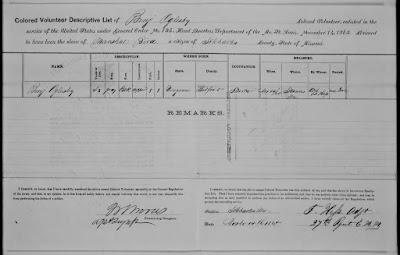 |
| Council officials with Benjamin Oglesby descendants at recent meeting (St. Charles County) |
The St.
Charles County Council in Missouri last week approved the honor for Benjamin
Oglesby, who fled captivity at age 39 and joined the 56th US Colored
Infantry Regiment.
The 199-acre Oglesby
Park, just west of Wentzville and near Interstate 70, will include playgrounds,
paths and shelters, county officials said. It is expected to open in July.
“We will have signage telling his story and we may even be relocating a 1920s Black school to the property, that was operated by the church where Mr. Oglesby and his family attended and sits on the same property where Mr. Oglesby and his wife are buried,” said Ben Gall, park historian.
In a press release,
County Executive Steve Ehlmann said, “The
history behind landowner Benjamin Oglesby and his family is both remarkable and
inspirational.”
Gall said his
research showed that Oglesby was born in Bedford, Virginia, about 1825. In the
mid-1830s, he came to St. Charles County with his enslaver Marshall Bird. The
farm near Foristell grew corn, wheat and tobacco.
In November
1864, Oglesby enlisted in the U.S. Army and was sent to Benton Barracks in St. Louis
for training. He was assigned to the 56th USCT, which conducted
military operations in Arkansas, including fighting at the Battle of Big Creek.
The regiment also fulfilled post and garrison duty (One of Oglesby's military records at left).
Oglesby was
honorably discharged in November 1865, outside Helena, Arkansas, Gall said.
Records kept
by the National Archives showed receipt of a $33.33 bounty when Oglesby was
mustered into service at Benton Barracks. Some $66.67 was due.
Gall said
Congress instituted a February 1864 draft that included Black men who lived in Border
States such as Missouri. “Loyal slaveowners” would be paid bounties for slaves who were freed and brought in the Army.
While there
are no definitive records in Oglesby’s case, Gall told the Picket, it seems the bounty was
due to the former slave because “his
file does not contain any records of Bird filling out the loyalty oath and
bounty … Recently freed Black soldiers did receive the bounty payment if their
owner was not considered loyal.”
 |
| The park site is just a couple miles north of I-70 (St. Charles County) |
After the Civil War, according to the 1870 census, Oglesby, his wife,
Martha and their six children -- Medora, Samuel, Oskar, Bell, Albert and
Charlie -- worked on a farm in Hickory Grove Township in Warren County,
officials said. In 1871, he purchased 146 acres of land in Foristell. He
financed the property through a $2,000 deed of trust and paid off the property
six years later.
“When Mr.
Oglesby died in 1901, the estate records indicate a nearly 50% increase in the
value of his property, demonstrating him as a successful farmer,” Gall wrote in
an email. “The property was still in the family through the
1960s.”
There are no
known photographs of Oglesby.
Barbara Love, the soldier’s great-great-granddaughter, told St. Louis TV station KMOV that her ancestor was determined to succeed after escaping slavery.
“He wanted to do something, not just for him, but for
family,” she said. “To say I’m a descendant of Benjamin Oglesby is a blessing.”
Love wrote on Facebook that her ancestor's story shows "you can be anything you want if you keep the faith."
 |
| Enlistment information for Benjamin Oglesby (click to enlarge, National Archives) |
“When looking
at the 19th century maps of the property, I saw the name
Benjamin Oglesby was marked as the owner of the property and decided to do a
little digging just to see who he was,” Gall wrote.
“The research
revealed a truly remarkable story of resilience, so I provided the name and
research to my supervisors for consideration. The director of the department,
who is a fellow historian, also found the story remarkable and decided to
officially propose it. When we learned there were descendants still active in
the community, it seemed to show this was meant to be.”
 |
| (Courtesy of St. Charles County) |

No comments:
Post a Comment